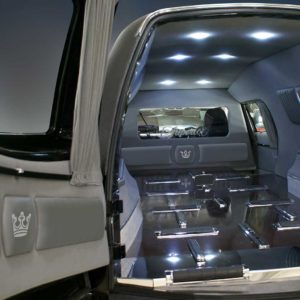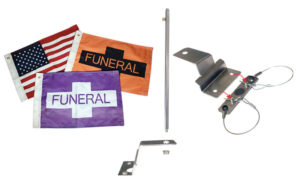The year 2020 has seen a lot of uncertainty, including the future of the livery vehicle conversion chassis. In 2019 Cadillac discontinued production of the XTS, the choice luxury sedan platform for specialty vehicle builders. It’s rival, the Lincoln MKT, has also discontinued in 2019, leaving us all wondering where to go from here?
While Lincoln remains in the air, GM has moved forward with the 2021 model of its mid-size crossover SUV, the Cadillac XT5, to the certified Cadillac Master Coachbuilders “CMC”. This year Cadillac gave the XT5 a refresh with subtle style changes, new technology, and revised livery trim options. Cadillac had previously offered a livery package for the XTS and CT6, which have both been discontinued.
As we speak, there are 2020 XT5 hearses and six-door limousines being proto-typed for development from the CMC convertors. Photos of a prototype with a significant longer wheel-base than the standard XT5 was spotted during testing back in September of this year, setting the internet into a buzz.
With the retirement of the XTS, the niche but very necessary funeral industry also has a need to be filled. By the end of the year we will begin to see the first XT5 hearses and these limousines hit the streets, which brings a lot of excitement to the industry.
Here at Infinite Innovations, we have been working hard with GM to develop the parts program to make this platform change possible.
Infinite has worked with both General Motors and Ford for over 3 decades to help engineer tooling and production to supply coachbuilders with the necessary interior and exterior parts to build specialty vehicles. Infinite has been there to make the process smooth for the builders during the development of many previous luxury conversion platforms including Lincoln Town Car & MKT models as well as Cadillac DeVille, DTS & XTS models, among others. Infinite also serves as a central stocking warehouse of these special OEM products as well as the parts that need to be longer to satisfy the needs of the additional stretched lengths of the coachbuilders. This allows operators to easily order replacement parts as well as accessories.
A lot goes into stretching and converting a vehicle into a hearse or limousine. The extended chassis requires factory style doors with OEM hinges, door handles, locking mechanisms, and interior trim to match the vehicle. Moldings for the stretch must be tooled to match the vehicle’s existing trim. Infinite Innovations has yet again served as the liaison between GM and the builders, making sure these needs are met to manufacture the new XT5 model conversion vehicles. We are excited as we move into this new platform and what the future holds for the livery industry.






